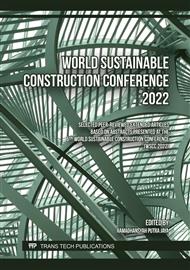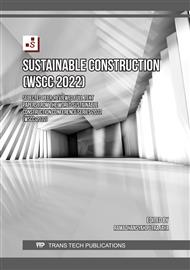[1]
Krarti, M. (2020). Energy audit of building systems: an engineering approach. CRC press.
Google Scholar
[2]
Tahir, M. Z., Nawi, M. N. M., & Zulhumadi, F. (2021). Strategy for Energy-Efficient Office Building of Public University in Malaysia: Case Study. International Journal of Sustainable Construction Engineering and Technology, 12(1), 100-109.
DOI: 10.30880/ijscet.2021.12.01.010
Google Scholar
[3]
Dhingra, A., & Saggu, T. S. (2021). Energy Conservation for a Sustainable Future. In Sustainable Development Through Engineering Innovations (pp.651-657). Springer, Singapore.
DOI: 10.1007/978-981-15-9554-7_58
Google Scholar
[4]
Osinubi, O. (2021). Energy Audit and Conservation Opportunity of Bottled Water Production. Available at SSRN 3912200.
DOI: 10.2139/ssrn.3912200
Google Scholar
[5]
Kralikova, R., Andrejiova, M., & Wessely, E. (2015). Energy saving techniques and strategies for illumination in industry. Procedia Engineering, 100, 187-195.
DOI: 10.1016/j.proeng.2015.01.357
Google Scholar
[6]
B. L. Capehart, M. B. Spiller, and S. Frazier, "Energy auditing," in Energy Management Handbook, River Publishers, 2020, p.31–49.
DOI: 10.1201/9781003151364-3
Google Scholar
[7]
Froufe, M. M., Chinelli, C. K., Guedes, A. L. A., Haddad, A. N., Hammad, A. W., & Soares, C. A. P. (2020). Smart buildings: Systems and drivers. Buildings, 10(9), 153.
DOI: 10.3390/buildings10090153
Google Scholar
[8]
Deb, C., & Schlueter, A. (2021). Review of data-driven energy modelling techniques for building retrofit. Renewable and Sustainable Energy Reviews, 144, 110990.
DOI: 10.1016/j.rser.2021.110990
Google Scholar
[9]
Murtagh, N., Scott, L., & Fan, J. (2020). Sustainable and resilient construction: Current status and future challenges. Journal of Cleaner Production, 268, 122264.
DOI: 10.1016/j.jclepro.2020.122264
Google Scholar
[10]
Salvadori, G., Fantozzi, F., Rocca, M., & Leccese, F. (2016). The energy audit activity focused on the lighting systems in historical buildings. Energies, 9(12), 998.
DOI: 10.3390/en9120998
Google Scholar
[11]
Mulla, F., Tambakad, S. S., & Patil, R. G. (2019, October). Energy conservation through lighting audit-a case study of hostel building. In 2019 3rd International Conference on Recent Developments in Control, Automation & Power Engineering (RDCAPE) (pp.191-196). IEEE.
DOI: 10.1109/rdcape47089.2019.8979100
Google Scholar
[12]
Zailan, R., & Kar, M. T. C. (2018). Energy Audit: A Case Study in FTK Building Universiti Malaysia Pahang. International Journal of Engineering Technology and Sciences, 5(2), 91-101.
DOI: 10.15282/ijets.v5i2.1400
Google Scholar
[13]
Nasir, S. N. S., Ludin, N. A., Radzi, A. A. S. M., Junedi, M. M., Ramli, N., Marsan, A., ... & Taip, Z. A. (2022). Lockdown impact on energy consumption in university building. Environment, Development and Sustainability, 1-20.
DOI: 10.1007/s10668-022-02507-z
Google Scholar
[14]
Gan, C. K., Sapar, A. F., Mun, Y. C., & Chong, K. E. (2013). Techno-economic analysis of LED lighting: A case study in UTeM's faculty building. Procedia Engineering, 53, 208-216.
DOI: 10.1016/j.proeng.2013.02.028
Google Scholar
[15]
Al-Taee, Y. A. K., & Sulaiman, M. K. A. M. (2021). Indoor Environmental Comfort in Student Hostel at Malaysia's Public University: A. Jurnal Kejuruteraan, 33(3), 487-501.
DOI: 10.17576/jkukm-2021-33(3)-11
Google Scholar
[16]
Husain, F. H. (2016). Lighting and performance: an analysis on lighting efficiency of architecture studio. Malaysian Journal of Sustainable Environment, 1(1), 92-105.
DOI: 10.24191/myse.v1i1.5563
Google Scholar
[17]
Ali, A. S., Chua, S. J. L., & Lim, M. E. L. (2018). Physical environment comfort towards Malaysian universities office employers' performance and productivity. Facilities.
DOI: 10.1108/f-06-2016-0060
Google Scholar
[18]
Hajjah Nor Maizura binti Yusoff. (2018). Guidelines on Occupational Safety and Health for Lighting at Workplace.
Google Scholar
[19]
Information on https://www.seda.gov.my/pdfdownload/malaysian-standards-ms-1525-2019-energy-efficiency-and-use-of-renewable-energy-for-non-residential-buildings/
Google Scholar
[20]
Information on https://www.lighting.philips.com/main/support/support/faqs/the-environment/ why-are-leds-considered-green-technology
Google Scholar



